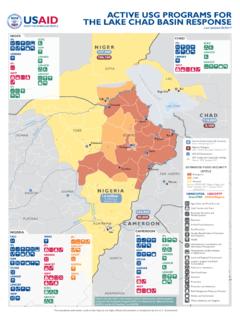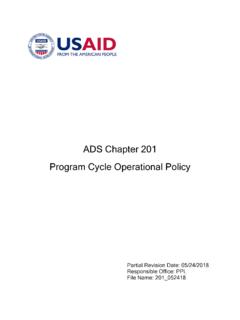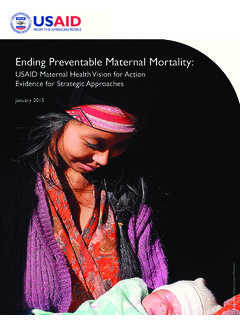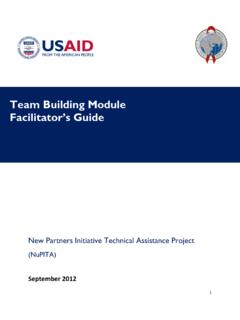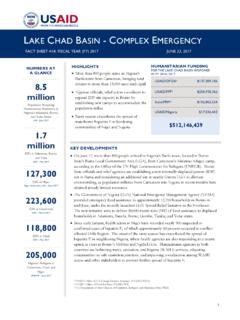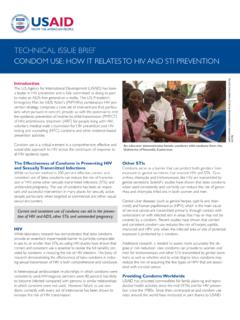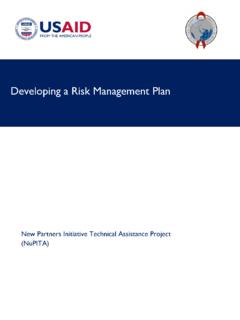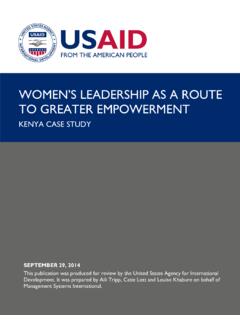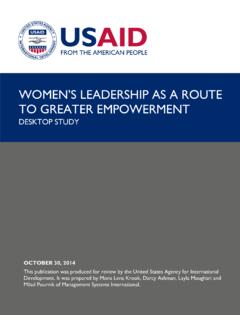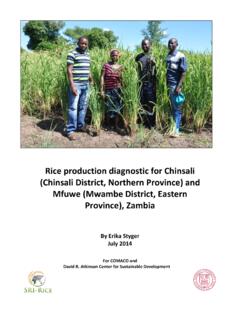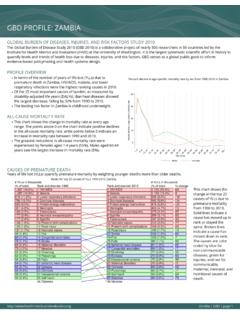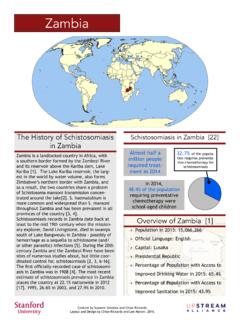Transcription of Zambia: Nutrition Profile - usaid.gov
1 zambia : Nutrition Profile Malnutrition in childhood and pregnancy has many adverse consequences for child survival and long-term well-being. It also has far-reaching consequences for human capital, economic productivity, and national development overall. The consequences of malnutrition should be a significant concern for policy makers in zambia , where million children (40 percent) under 5 years suffer from chronic malnutrition (stunting or low height-for-age) and 420,000 children (15 percent) under 5 years suffer from acute malnutrition (wasting or low weight-for-height), according to the most recent Demographic and Health Survey (DHS) (Central Statistical Office [CSO] [ zambia ], Ministry of Health [MOH][ zambia ], and ICF International 2014).
2 Background zambia experienced rapid economic growth during the past decade and graduated from a low-income to a lower-middle-income country in 2011. However, hard hit by lower copper prices and domestic pressures, including a poor harvest after an El-Ni o-induced drought in 2015, a power crisis, and political uncertainty in the lead-up to 2016 elections, in 2015 the economy had tumbled to its lowest since 1998, with growth registering just percent. The economy is slowly recovering and growth is forecast to strengthen to percent in 2018 and percent in 2019 (World Bank 2017). Poverty remains high in rural areas, where nearly 60 percent of the population lives.
3 Fifty-four percent of Zambians continue to live on less than US$ a day (Sachs et al. 2017). zambia ranks among the top 20 countries in the world for relative income inequality (USAID 2017). Relative to other countries in the region, however, zambia has an abundance of water and fertile land, as well as a generally favorable climate for agricultural production (USAID 2017). Agriculture employs 70 percent of the labor force ( zambia Ministry of Agriculture, Livestock and Fisheries 2011). Though stable for most of its post-colonial history, the country entered a new phase when President Edgar Lungu and his zambia s Patriotic Front government were re-elected in a closely contested presidential race in August 2016.
4 He has called for an end to moral decay and national transformation to address high levels of poverty, and has initiated a reform to the Lands Act to avoid the indiscriminate and illegal sale of land in the country (World Bank 2017). Currently, zambia ranks 134th out of 157 countries in progress toward meeting the Sustainable Development Goals (SDGs) (Sachs et al. 2017). Infant and under-5 mortality rates are 45 and 75 deaths per 1,000 live births, respectively. At these mortality levels, 1 in every 22 Zambian children will die before reaching his or her first birthday, and one in every 13 will not survive to his or her fifth birthday (CSO, MOH, and ICF International 2014).
5 Nutrition and Food Security Situation Malnutrition is a major burden on the Zambian health care system and contributes to low human capital. Nationally, 40 percent of children under 5 years are stunted. Analysis by age groups shows that stunting is highest (54 percent) in children 18 23 months and lowest (14 percent) in children under 6 months. Children in rural areas (42 percent) are more likely to be stunted than those in urban areas (36 percent). At the provincial level, Northern has the highest proportion of stunted children (49 percent), while Copperbelt, Lusaka, and Western have the lowest proportions (36 percent each).
6 A mother s level of education generally has an inverse relationship with stunting levels; stunting ranges from a low of 18 percent among children whose mothers have more than a secondary education to a high of 45 percent among those whose mothers have no education. A similar inverse relationship is observed between stunting and 1 Updated February 2018 wealth.
7 Children in the poorest households are much more likely to be stunted (47 percent) than children in the wealthiest households (28 percent) (CSO, MOH, and ICF International 2014). Overall, 6 percent of children are wasted. Analysis by age group shows that wasting ranges from 5 percent among children 24 59 months to 10 percent among those 9 11 months. Wasting does not vary extensively by gender, by length of preceding birth interval, or by residence. Wasting is most likely to occur among babies who were very small or small at birth (9 percent) and least likely among those whose birth size was average or larger (6 percent). Wasting is slightly higher among children whose mothers are thin than among those whose mothers are normal, overweight, or obese (8 percent versus 6 percent).
8 By province, wasting is highest among children in Luapula (13 percent) and lowest among children in Muchinga, Northern, and Southern (4 percent each). There is no major variation in wasting by a mother s education or household wealth (CSO, MOH, and ICF International 2014). Childbearing begins early in zambia . By age 19, 59 percent of adolescent girls had begun childbearing in 2013 2014, which is an increase from 55 percent in 2007 (CSO, MOH, and ICF International 2014). This has serious consequences because, relative to older mothers, adolescent girls are more likely to be malnourished and have a low birth weight baby who is more likely to become malnourished, and be at increased risk of illness and death than those born to older mothers.
9 The risk of stunting is 33 percent higher among first-born children of girls under 18 years in Sub-Saharan Africa, and as such, early motherhood is a key driver of malnutrition (Fink et al. 2014). High morbidity, limited access to health services, poverty, and food insecurity are the major determinants of undernutrition in children. Although exclusive breastfeeding from 0 5 months increased to 73 percent, it drops to 45 percent among children 4 5 months, and only 12 percent of children 6 23 months receive a minimum acceptable diet, which has a major impact on their growth and development (CSO, MOH, and ICF International 2014).
10 zambia also has a high HIV prevalence of 13 percent among adults 15 49 (15 percent of women and 11 percent of men). A comparison of the HIV prevalence estimates indicates that HIV prevalence among adults in zambia has decreased over time (from 16 percent in 2001 02 to 13 percent in 2013 14) (CSO, MOH, and ICF International 2014). HIV can cause or aggravate malnutrition through reduced food intake, increased energy needs, and poor nutrient absorption. In turn, malnutrition can hasten the progression of HIV and worsen its impact by weakening the immune system and impairing an individual s ability to fight and recover from illness.
